In the mass production of CNC precision hardware parts processing, because the workpiece requires high precision and short delivery time, the efficiency of the equipment is the top priority of the production and processing. Being able to grasp simple basic knowledge can not only improve the productivity of hardware accessories processing, but also reduce the failure rate of the equipment during use.
Let me tell you some basic knowledge of CNC precision hardware parts processing
1. Chip control
Chips entangled around the tool or work piece for long successive cuts. Generally caused by low feed, low and/or shallow depth of cut of the geometry.
reason:
(1) The feed for the selected groove is too low.
Solution: Progressive feed.
(2) The cutting depth of the selected groove is too shallow.
Solution: Choose the blade geometry with stronger chip breaking. Increase the coolant flow rate.
(3) The tool nose radius is too large.
Solution: Add a cutting depth or choose a stronger geometry for chip breaking.
(4) Improper entering angle.
Solution: Choose a smaller nose radius.
2. Appearance quality
It looks and feels “hairy” in appearance and does not meet the requirements of public service.
reason:
(1) Chip breaking passes through the hitting parts and leaves traces on the processed surface.
Solution: Choose the groove shape that guides chip removal. Change the entering angle, lower the cutting depth, and select the positive rake angle tool system with the inclination of the central blade.
(2) The reason for the hairy appearance is that the groove wear on the cutting edge is too severe.
Solution: Choose a brand with better oxidation and wear resistance, such as a cermet brand, and adjust to reduce the cutting speed.
(3) The combination of too high feed and too small tool tip fillet will result in a rough appearance.
Solution: Choose a larger tool nose radius and lower feed.
3. Burr composition
When cutting away from the workpiece, a burr is formed at the end of the cutting.
reason:
(1) The cutting edge is not sharp.
Solution: Use blades with sharp cutting edges:-Fine grinding blades with small feed rate (<0.1mm/r).
(2) The feed is too low for the roundness of the cutting edge.
Solution: Use a tool holder with a small entering angle.
(3) Groove wear or chipping at the cutting depth of CNC precision hardware processing.
Solution: When leaving the workpiece, complete the cutting with a chamfer or radius.
4. Oscillation
High radial cutting force, cause: oscillation or trembling scratches caused by the tool or tool device. Generally, it appears when the boring bar is used for inner circle machining.
reason:
(1) Inappropriate entering angle.
Solution: Choose a larger entering angle (kr=90°).
(2) The tool nose radius is too large.
Solution: Choose a small nose radius.
(3) Inappropriate cutting edge roundness, or negative chamfering.
Solution: Choose a trademark with a thin coating, or a non-coated trademark.
(4) Excessive flank wear on the cutting edge.
Solution: Choose a more wear-resistant trademark or adjust to reduce the cutting speed.
Post time: Dec-16-2021

